Human Resource Management Report: M&S Workforce Planning
VerifiedAdded on 2023/01/11
|20
|6560
|90
Report
AI Summary
This report offers a comprehensive analysis of Human Resource Management (HRM) practices at Marks & Spencer (M&S). It begins by defining HRM and its purpose in workforce planning and resourcing, followed by an examination of internal and external recruitment methods, including their strengths and weaknesses. The report then explores the benefits of various HRM practices, such as training and development, for both employers and employees, and evaluates their impact on organizational profit and productivity. Furthermore, it delves into the importance of employee relations in influencing HRM decision-making and identifies key elements of employment legislation and its impact. The report concludes with practical examples of HRM practices in a work-related context, such as job descriptions and interview notes, providing a holistic view of HRM implementation at M&S.
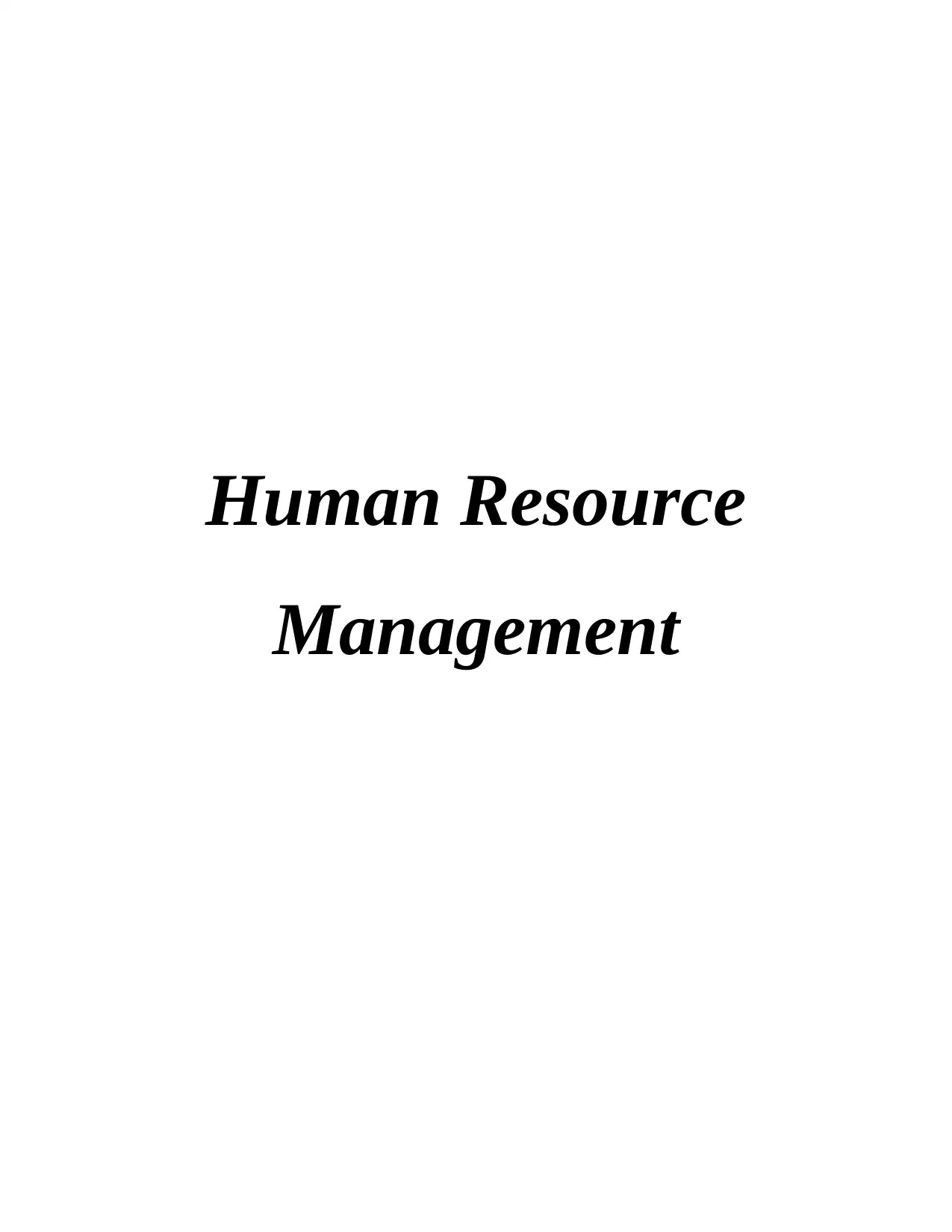
Human Resource
Management
Management
Paraphrase This Document
Need a fresh take? Get an instant paraphrase of this document with our AI Paraphraser
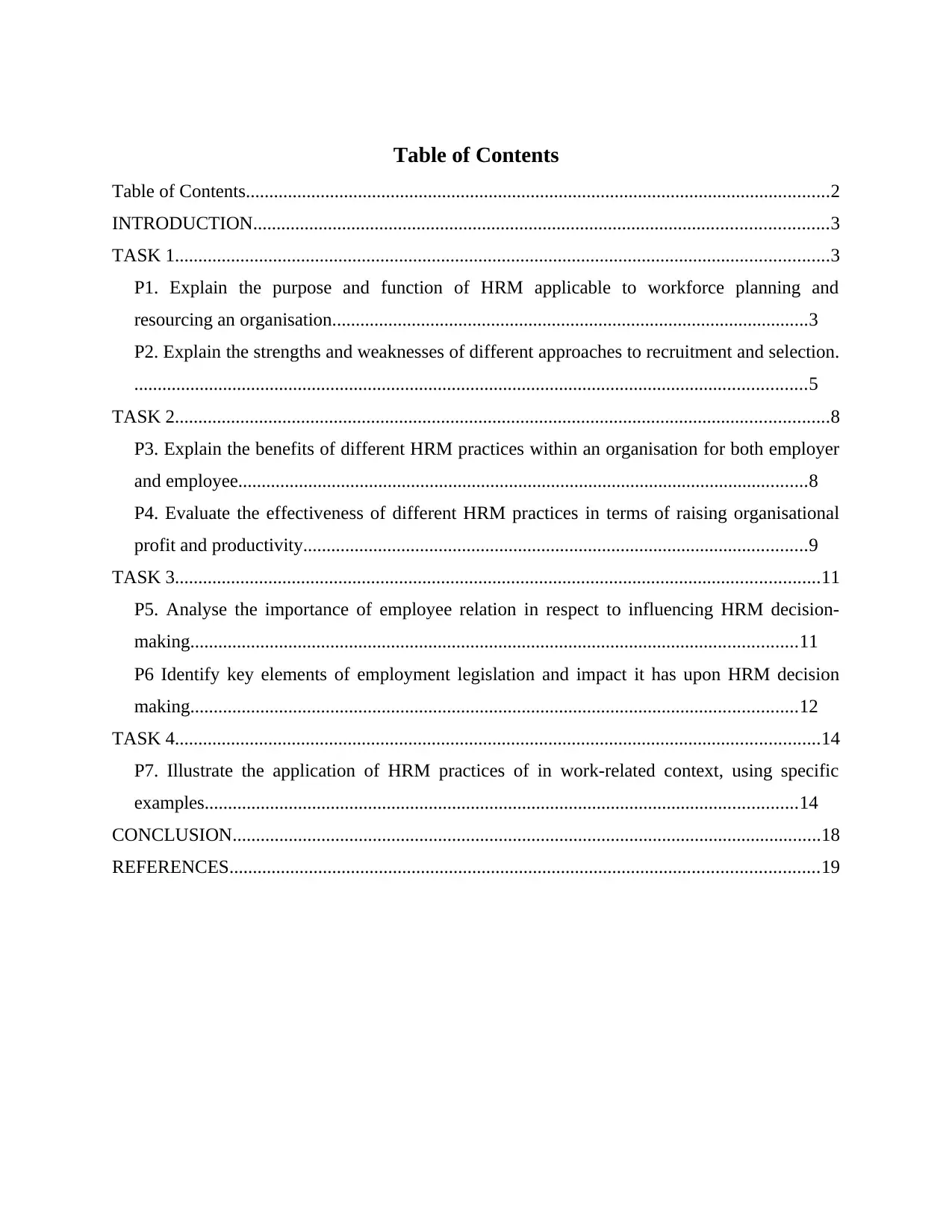
Table of Contents
Table of Contents.............................................................................................................................2
INTRODUCTION...........................................................................................................................3
TASK 1............................................................................................................................................3
P1. Explain the purpose and function of HRM applicable to workforce planning and
resourcing an organisation......................................................................................................3
P2. Explain the strengths and weaknesses of different approaches to recruitment and selection.
................................................................................................................................................5
TASK 2............................................................................................................................................8
P3. Explain the benefits of different HRM practices within an organisation for both employer
and employee..........................................................................................................................8
P4. Evaluate the effectiveness of different HRM practices in terms of raising organisational
profit and productivity............................................................................................................9
TASK 3..........................................................................................................................................11
P5. Analyse the importance of employee relation in respect to influencing HRM decision-
making..................................................................................................................................11
P6 Identify key elements of employment legislation and impact it has upon HRM decision
making..................................................................................................................................12
TASK 4..........................................................................................................................................14
P7. Illustrate the application of HRM practices of in work-related context, using specific
examples...............................................................................................................................14
CONCLUSION..............................................................................................................................18
REFERENCES..............................................................................................................................19
Table of Contents.............................................................................................................................2
INTRODUCTION...........................................................................................................................3
TASK 1............................................................................................................................................3
P1. Explain the purpose and function of HRM applicable to workforce planning and
resourcing an organisation......................................................................................................3
P2. Explain the strengths and weaknesses of different approaches to recruitment and selection.
................................................................................................................................................5
TASK 2............................................................................................................................................8
P3. Explain the benefits of different HRM practices within an organisation for both employer
and employee..........................................................................................................................8
P4. Evaluate the effectiveness of different HRM practices in terms of raising organisational
profit and productivity............................................................................................................9
TASK 3..........................................................................................................................................11
P5. Analyse the importance of employee relation in respect to influencing HRM decision-
making..................................................................................................................................11
P6 Identify key elements of employment legislation and impact it has upon HRM decision
making..................................................................................................................................12
TASK 4..........................................................................................................................................14
P7. Illustrate the application of HRM practices of in work-related context, using specific
examples...............................................................................................................................14
CONCLUSION..............................................................................................................................18
REFERENCES..............................................................................................................................19
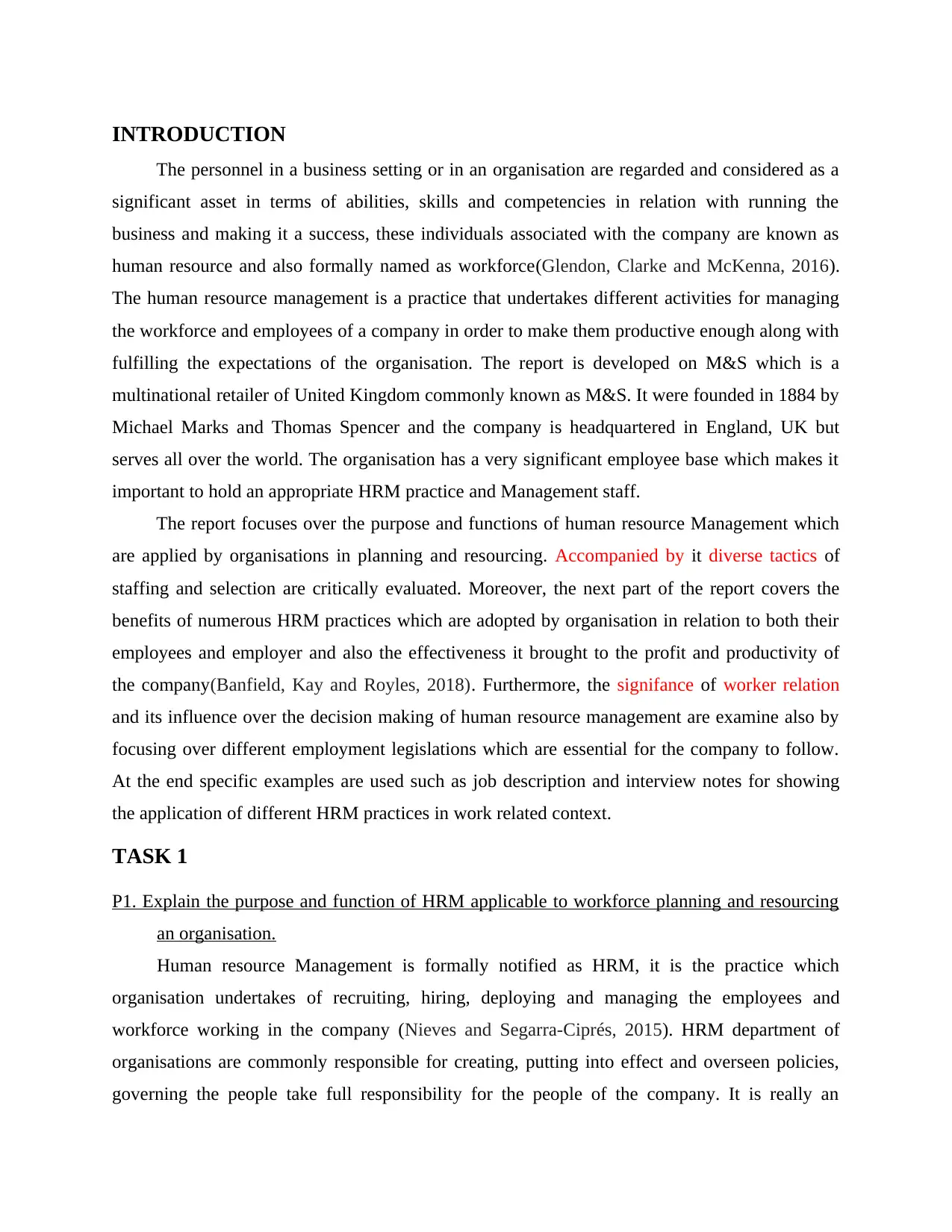
INTRODUCTION
The personnel in a business setting or in an organisation are regarded and considered as a
significant asset in terms of abilities, skills and competencies in relation with running the
business and making it a success, these individuals associated with the company are known as
human resource and also formally named as workforce(Glendon, Clarke and McKenna, 2016).
The human resource management is a practice that undertakes different activities for managing
the workforce and employees of a company in order to make them productive enough along with
fulfilling the expectations of the organisation. The report is developed on M&S which is a
multinational retailer of United Kingdom commonly known as M&S. It were founded in 1884 by
Michael Marks and Thomas Spencer and the company is headquartered in England, UK but
serves all over the world. The organisation has a very significant employee base which makes it
important to hold an appropriate HRM practice and Management staff.
The report focuses over the purpose and functions of human resource Management which
are applied by organisations in planning and resourcing. Accompanied by it diverse tactics of
staffing and selection are critically evaluated. Moreover, the next part of the report covers the
benefits of numerous HRM practices which are adopted by organisation in relation to both their
employees and employer and also the effectiveness it brought to the profit and productivity of
the company(Banfield, Kay and Royles, 2018). Furthermore, the signifance of worker relation
and its influence over the decision making of human resource management are examine also by
focusing over different employment legislations which are essential for the company to follow.
At the end specific examples are used such as job description and interview notes for showing
the application of different HRM practices in work related context.
TASK 1
P1. Explain the purpose and function of HRM applicable to workforce planning and resourcing
an organisation.
Human resource Management is formally notified as HRM, it is the practice which
organisation undertakes of recruiting, hiring, deploying and managing the employees and
workforce working in the company (Nieves and Segarra-Ciprés, 2015). HRM department of
organisations are commonly responsible for creating, putting into effect and overseen policies,
governing the people take full responsibility for the people of the company. It is really an
The personnel in a business setting or in an organisation are regarded and considered as a
significant asset in terms of abilities, skills and competencies in relation with running the
business and making it a success, these individuals associated with the company are known as
human resource and also formally named as workforce(Glendon, Clarke and McKenna, 2016).
The human resource management is a practice that undertakes different activities for managing
the workforce and employees of a company in order to make them productive enough along with
fulfilling the expectations of the organisation. The report is developed on M&S which is a
multinational retailer of United Kingdom commonly known as M&S. It were founded in 1884 by
Michael Marks and Thomas Spencer and the company is headquartered in England, UK but
serves all over the world. The organisation has a very significant employee base which makes it
important to hold an appropriate HRM practice and Management staff.
The report focuses over the purpose and functions of human resource Management which
are applied by organisations in planning and resourcing. Accompanied by it diverse tactics of
staffing and selection are critically evaluated. Moreover, the next part of the report covers the
benefits of numerous HRM practices which are adopted by organisation in relation to both their
employees and employer and also the effectiveness it brought to the profit and productivity of
the company(Banfield, Kay and Royles, 2018). Furthermore, the signifance of worker relation
and its influence over the decision making of human resource management are examine also by
focusing over different employment legislations which are essential for the company to follow.
At the end specific examples are used such as job description and interview notes for showing
the application of different HRM practices in work related context.
TASK 1
P1. Explain the purpose and function of HRM applicable to workforce planning and resourcing
an organisation.
Human resource Management is formally notified as HRM, it is the practice which
organisation undertakes of recruiting, hiring, deploying and managing the employees and
workforce working in the company (Nieves and Segarra-Ciprés, 2015). HRM department of
organisations are commonly responsible for creating, putting into effect and overseen policies,
governing the people take full responsibility for the people of the company. It is really an
⊘ This is a preview!⊘
Do you want full access?
Subscribe today to unlock all pages.

Trusted by 1+ million students worldwide
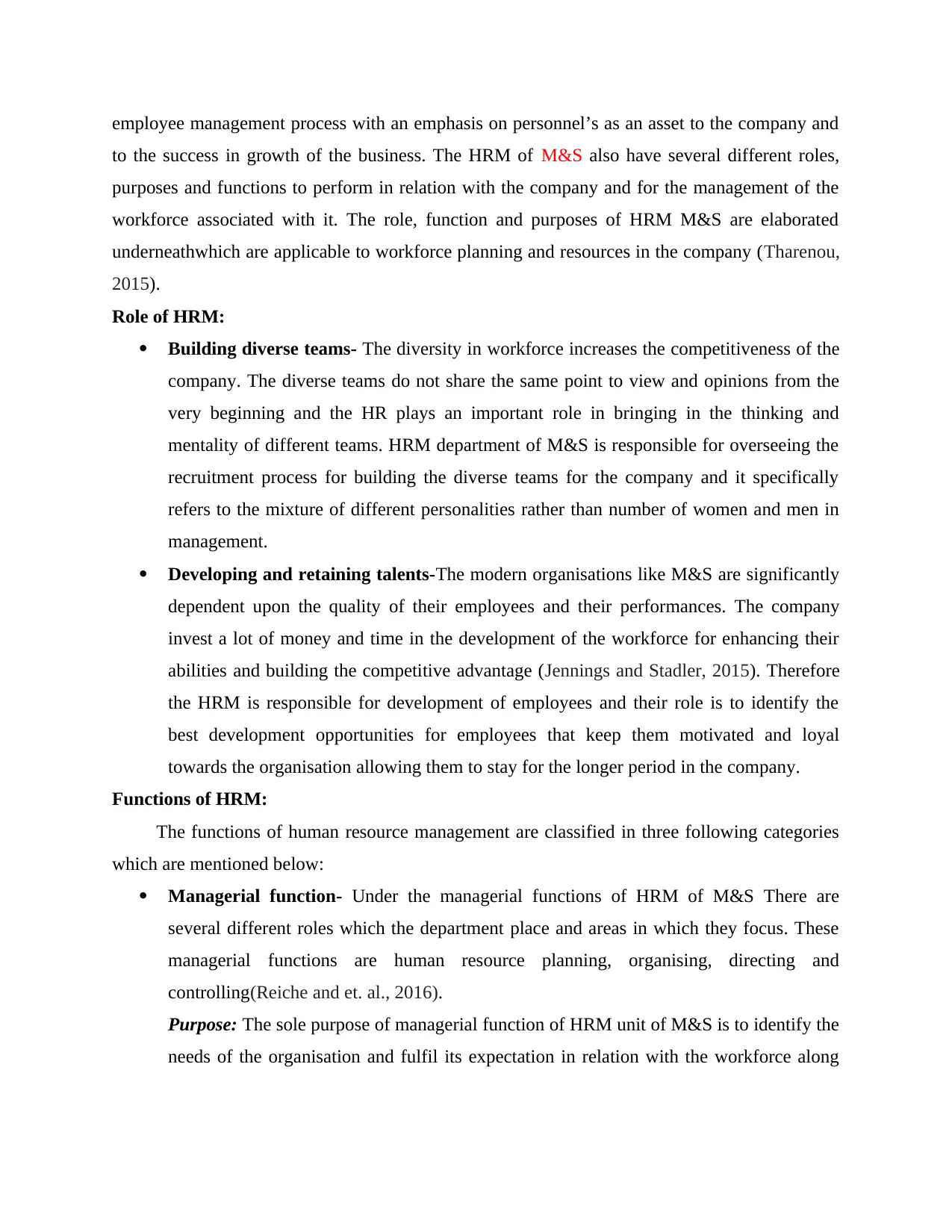
employee management process with an emphasis on personnel’s as an asset to the company and
to the success in growth of the business. The HRM of M&S also have several different roles,
purposes and functions to perform in relation with the company and for the management of the
workforce associated with it. The role, function and purposes of HRM M&S are elaborated
underneathwhich are applicable to workforce planning and resources in the company (Tharenou,
2015).
Role of HRM:
Building diverse teams- The diversity in workforce increases the competitiveness of the
company. The diverse teams do not share the same point to view and opinions from the
very beginning and the HR plays an important role in bringing in the thinking and
mentality of different teams. HRM department of M&S is responsible for overseeing the
recruitment process for building the diverse teams for the company and it specifically
refers to the mixture of different personalities rather than number of women and men in
management.
Developing and retaining talents-The modern organisations like M&S are significantly
dependent upon the quality of their employees and their performances. The company
invest a lot of money and time in the development of the workforce for enhancing their
abilities and building the competitive advantage (Jennings and Stadler, 2015). Therefore
the HRM is responsible for development of employees and their role is to identify the
best development opportunities for employees that keep them motivated and loyal
towards the organisation allowing them to stay for the longer period in the company.
Functions of HRM:
The functions of human resource management are classified in three following categories
which are mentioned below:
Managerial function- Under the managerial functions of HRM of M&S There are
several different roles which the department place and areas in which they focus. These
managerial functions are human resource planning, organising, directing and
controlling(Reiche and et. al., 2016).
Purpose: The sole purpose of managerial function of HRM unit of M&S is to identify the
needs of the organisation and fulfil its expectation in relation with the workforce along
to the success in growth of the business. The HRM of M&S also have several different roles,
purposes and functions to perform in relation with the company and for the management of the
workforce associated with it. The role, function and purposes of HRM M&S are elaborated
underneathwhich are applicable to workforce planning and resources in the company (Tharenou,
2015).
Role of HRM:
Building diverse teams- The diversity in workforce increases the competitiveness of the
company. The diverse teams do not share the same point to view and opinions from the
very beginning and the HR plays an important role in bringing in the thinking and
mentality of different teams. HRM department of M&S is responsible for overseeing the
recruitment process for building the diverse teams for the company and it specifically
refers to the mixture of different personalities rather than number of women and men in
management.
Developing and retaining talents-The modern organisations like M&S are significantly
dependent upon the quality of their employees and their performances. The company
invest a lot of money and time in the development of the workforce for enhancing their
abilities and building the competitive advantage (Jennings and Stadler, 2015). Therefore
the HRM is responsible for development of employees and their role is to identify the
best development opportunities for employees that keep them motivated and loyal
towards the organisation allowing them to stay for the longer period in the company.
Functions of HRM:
The functions of human resource management are classified in three following categories
which are mentioned below:
Managerial function- Under the managerial functions of HRM of M&S There are
several different roles which the department place and areas in which they focus. These
managerial functions are human resource planning, organising, directing and
controlling(Reiche and et. al., 2016).
Purpose: The sole purpose of managerial function of HRM unit of M&S is to identify the
needs of the organisation and fulfil its expectation in relation with the workforce along
Paraphrase This Document
Need a fresh take? Get an instant paraphrase of this document with our AI Paraphraser
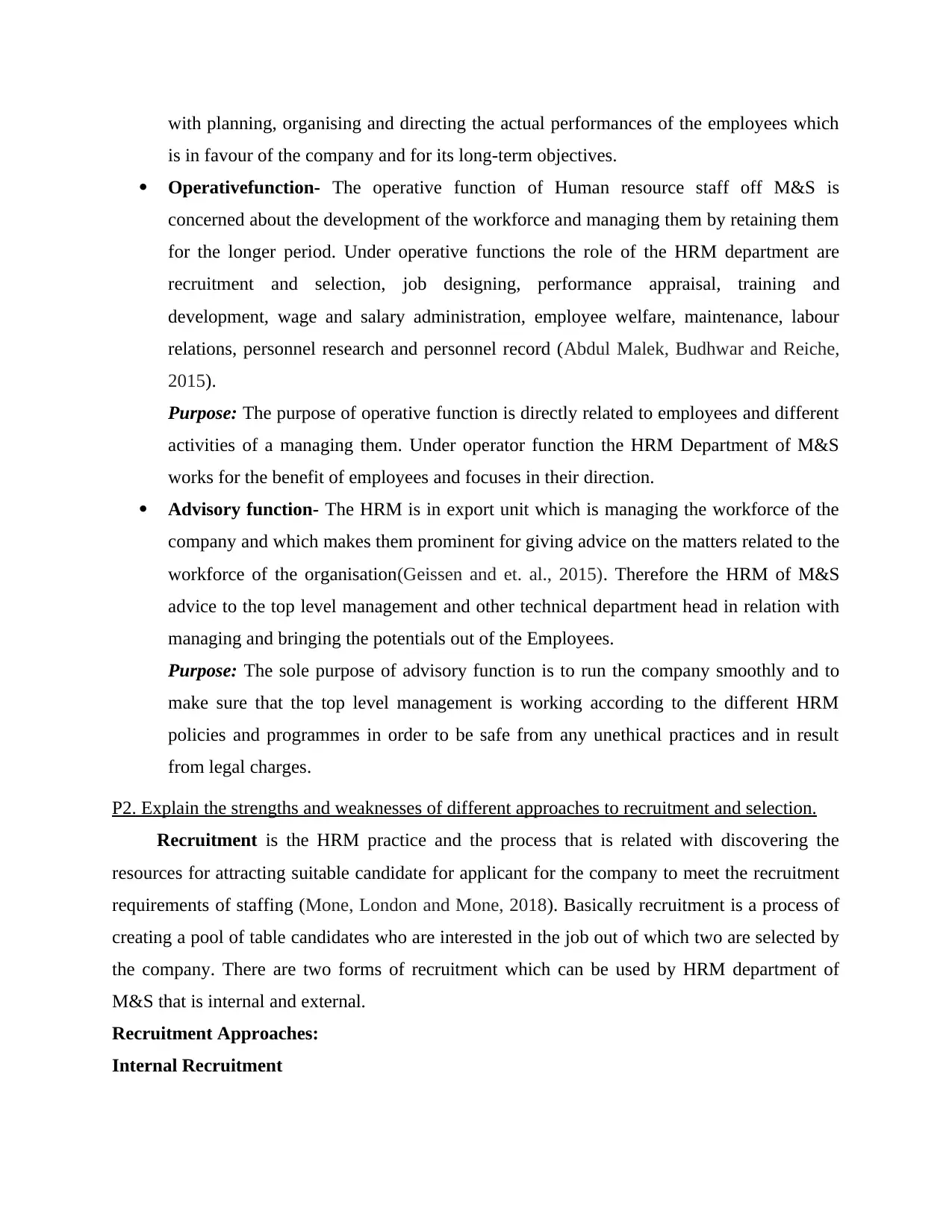
with planning, organising and directing the actual performances of the employees which
is in favour of the company and for its long-term objectives.
Operativefunction- The operative function of Human resource staff off M&S is
concerned about the development of the workforce and managing them by retaining them
for the longer period. Under operative functions the role of the HRM department are
recruitment and selection, job designing, performance appraisal, training and
development, wage and salary administration, employee welfare, maintenance, labour
relations, personnel research and personnel record (Abdul Malek, Budhwar and Reiche,
2015).
Purpose: The purpose of operative function is directly related to employees and different
activities of a managing them. Under operator function the HRM Department of M&S
works for the benefit of employees and focuses in their direction.
Advisory function- The HRM is in export unit which is managing the workforce of the
company and which makes them prominent for giving advice on the matters related to the
workforce of the organisation(Geissen and et. al., 2015). Therefore the HRM of M&S
advice to the top level management and other technical department head in relation with
managing and bringing the potentials out of the Employees.
Purpose: The sole purpose of advisory function is to run the company smoothly and to
make sure that the top level management is working according to the different HRM
policies and programmes in order to be safe from any unethical practices and in result
from legal charges.
P2. Explain the strengths and weaknesses of different approaches to recruitment and selection.
Recruitment is the HRM practice and the process that is related with discovering the
resources for attracting suitable candidate for applicant for the company to meet the recruitment
requirements of staffing (Mone, London and Mone, 2018). Basically recruitment is a process of
creating a pool of table candidates who are interested in the job out of which two are selected by
the company. There are two forms of recruitment which can be used by HRM department of
M&S that is internal and external.
Recruitment Approaches:
Internal Recruitment
is in favour of the company and for its long-term objectives.
Operativefunction- The operative function of Human resource staff off M&S is
concerned about the development of the workforce and managing them by retaining them
for the longer period. Under operative functions the role of the HRM department are
recruitment and selection, job designing, performance appraisal, training and
development, wage and salary administration, employee welfare, maintenance, labour
relations, personnel research and personnel record (Abdul Malek, Budhwar and Reiche,
2015).
Purpose: The purpose of operative function is directly related to employees and different
activities of a managing them. Under operator function the HRM Department of M&S
works for the benefit of employees and focuses in their direction.
Advisory function- The HRM is in export unit which is managing the workforce of the
company and which makes them prominent for giving advice on the matters related to the
workforce of the organisation(Geissen and et. al., 2015). Therefore the HRM of M&S
advice to the top level management and other technical department head in relation with
managing and bringing the potentials out of the Employees.
Purpose: The sole purpose of advisory function is to run the company smoothly and to
make sure that the top level management is working according to the different HRM
policies and programmes in order to be safe from any unethical practices and in result
from legal charges.
P2. Explain the strengths and weaknesses of different approaches to recruitment and selection.
Recruitment is the HRM practice and the process that is related with discovering the
resources for attracting suitable candidate for applicant for the company to meet the recruitment
requirements of staffing (Mone, London and Mone, 2018). Basically recruitment is a process of
creating a pool of table candidates who are interested in the job out of which two are selected by
the company. There are two forms of recruitment which can be used by HRM department of
M&S that is internal and external.
Recruitment Approaches:
Internal Recruitment
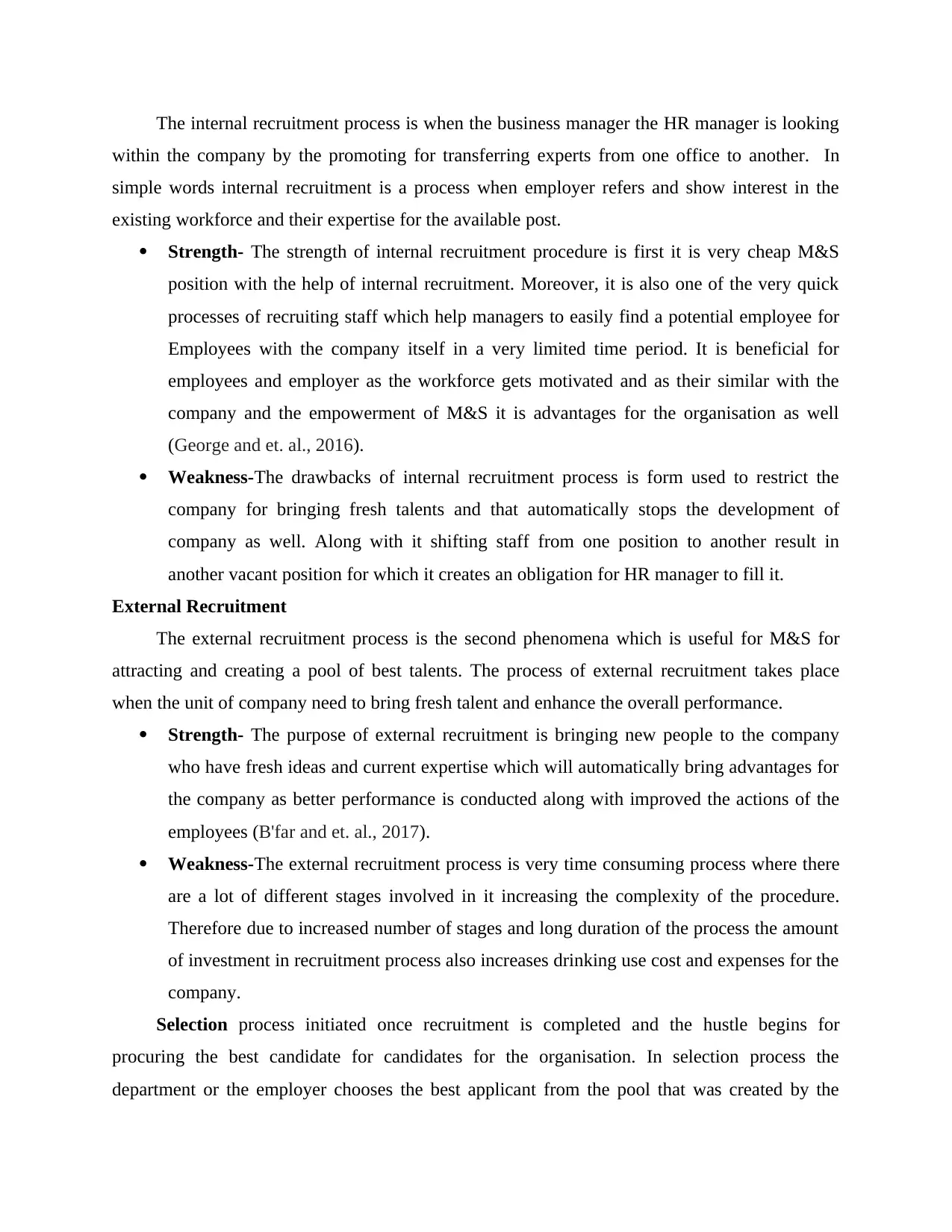
The internal recruitment process is when the business manager the HR manager is looking
within the company by the promoting for transferring experts from one office to another. In
simple words internal recruitment is a process when employer refers and show interest in the
existing workforce and their expertise for the available post.
Strength- The strength of internal recruitment procedure is first it is very cheap M&S
position with the help of internal recruitment. Moreover, it is also one of the very quick
processes of recruiting staff which help managers to easily find a potential employee for
Employees with the company itself in a very limited time period. It is beneficial for
employees and employer as the workforce gets motivated and as their similar with the
company and the empowerment of M&S it is advantages for the organisation as well
(George and et. al., 2016).
Weakness-The drawbacks of internal recruitment process is form used to restrict the
company for bringing fresh talents and that automatically stops the development of
company as well. Along with it shifting staff from one position to another result in
another vacant position for which it creates an obligation for HR manager to fill it.
External Recruitment
The external recruitment process is the second phenomena which is useful for M&S for
attracting and creating a pool of best talents. The process of external recruitment takes place
when the unit of company need to bring fresh talent and enhance the overall performance.
Strength- The purpose of external recruitment is bringing new people to the company
who have fresh ideas and current expertise which will automatically bring advantages for
the company as better performance is conducted along with improved the actions of the
employees (B'far and et. al., 2017).
Weakness-The external recruitment process is very time consuming process where there
are a lot of different stages involved in it increasing the complexity of the procedure.
Therefore due to increased number of stages and long duration of the process the amount
of investment in recruitment process also increases drinking use cost and expenses for the
company.
Selection process initiated once recruitment is completed and the hustle begins for
procuring the best candidate for candidates for the organisation. In selection process the
department or the employer chooses the best applicant from the pool that was created by the
within the company by the promoting for transferring experts from one office to another. In
simple words internal recruitment is a process when employer refers and show interest in the
existing workforce and their expertise for the available post.
Strength- The strength of internal recruitment procedure is first it is very cheap M&S
position with the help of internal recruitment. Moreover, it is also one of the very quick
processes of recruiting staff which help managers to easily find a potential employee for
Employees with the company itself in a very limited time period. It is beneficial for
employees and employer as the workforce gets motivated and as their similar with the
company and the empowerment of M&S it is advantages for the organisation as well
(George and et. al., 2016).
Weakness-The drawbacks of internal recruitment process is form used to restrict the
company for bringing fresh talents and that automatically stops the development of
company as well. Along with it shifting staff from one position to another result in
another vacant position for which it creates an obligation for HR manager to fill it.
External Recruitment
The external recruitment process is the second phenomena which is useful for M&S for
attracting and creating a pool of best talents. The process of external recruitment takes place
when the unit of company need to bring fresh talent and enhance the overall performance.
Strength- The purpose of external recruitment is bringing new people to the company
who have fresh ideas and current expertise which will automatically bring advantages for
the company as better performance is conducted along with improved the actions of the
employees (B'far and et. al., 2017).
Weakness-The external recruitment process is very time consuming process where there
are a lot of different stages involved in it increasing the complexity of the procedure.
Therefore due to increased number of stages and long duration of the process the amount
of investment in recruitment process also increases drinking use cost and expenses for the
company.
Selection process initiated once recruitment is completed and the hustle begins for
procuring the best candidate for candidates for the organisation. In selection process the
department or the employer chooses the best applicant from the pool that was created by the
⊘ This is a preview!⊘
Do you want full access?
Subscribe today to unlock all pages.

Trusted by 1+ million students worldwide
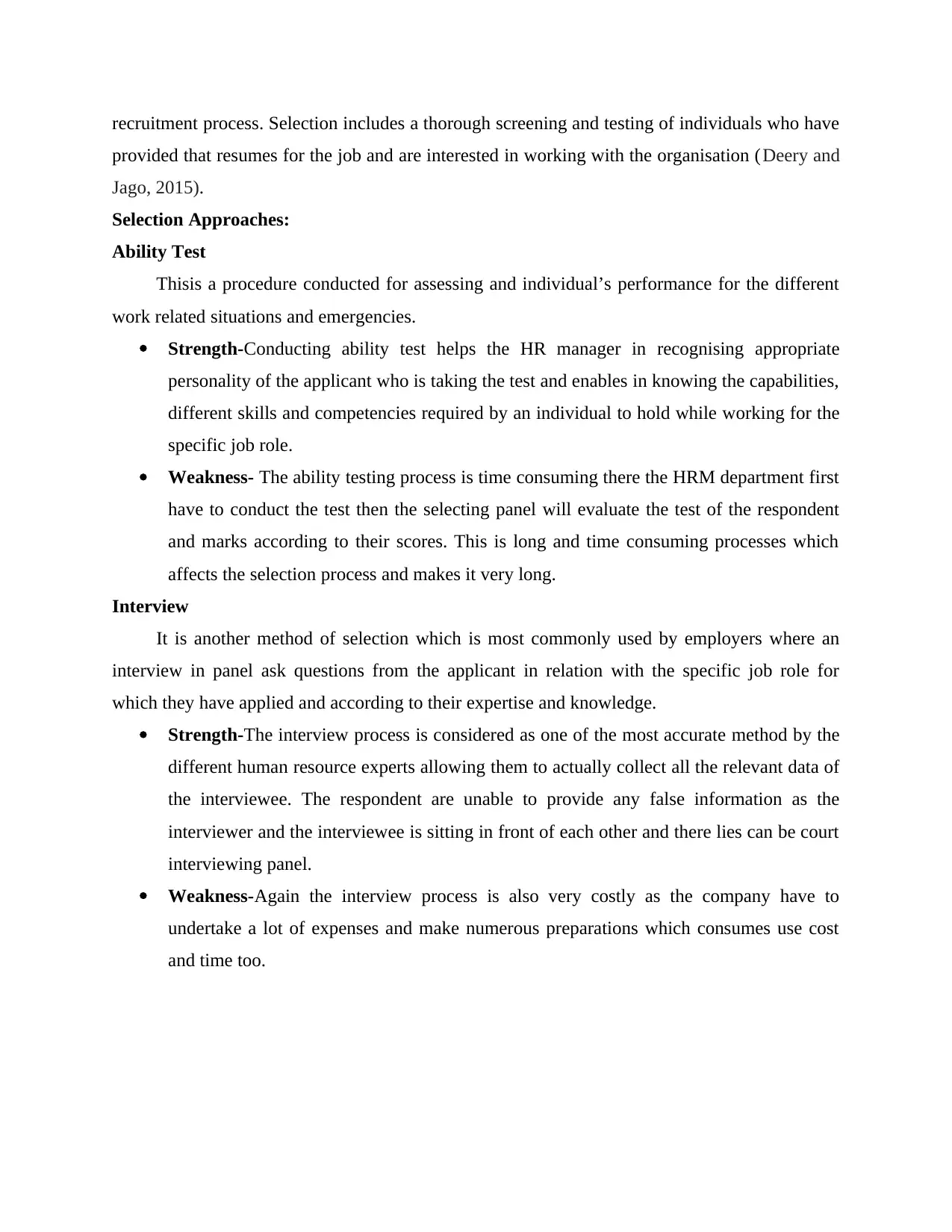
recruitment process. Selection includes a thorough screening and testing of individuals who have
provided that resumes for the job and are interested in working with the organisation (Deery and
Jago, 2015).
Selection Approaches:
Ability Test
Thisis a procedure conducted for assessing and individual’s performance for the different
work related situations and emergencies.
Strength-Conducting ability test helps the HR manager in recognising appropriate
personality of the applicant who is taking the test and enables in knowing the capabilities,
different skills and competencies required by an individual to hold while working for the
specific job role.
Weakness- The ability testing process is time consuming there the HRM department first
have to conduct the test then the selecting panel will evaluate the test of the respondent
and marks according to their scores. This is long and time consuming processes which
affects the selection process and makes it very long.
Interview
It is another method of selection which is most commonly used by employers where an
interview in panel ask questions from the applicant in relation with the specific job role for
which they have applied and according to their expertise and knowledge.
Strength-The interview process is considered as one of the most accurate method by the
different human resource experts allowing them to actually collect all the relevant data of
the interviewee. The respondent are unable to provide any false information as the
interviewer and the interviewee is sitting in front of each other and there lies can be court
interviewing panel.
Weakness-Again the interview process is also very costly as the company have to
undertake a lot of expenses and make numerous preparations which consumes use cost
and time too.
provided that resumes for the job and are interested in working with the organisation (Deery and
Jago, 2015).
Selection Approaches:
Ability Test
Thisis a procedure conducted for assessing and individual’s performance for the different
work related situations and emergencies.
Strength-Conducting ability test helps the HR manager in recognising appropriate
personality of the applicant who is taking the test and enables in knowing the capabilities,
different skills and competencies required by an individual to hold while working for the
specific job role.
Weakness- The ability testing process is time consuming there the HRM department first
have to conduct the test then the selecting panel will evaluate the test of the respondent
and marks according to their scores. This is long and time consuming processes which
affects the selection process and makes it very long.
Interview
It is another method of selection which is most commonly used by employers where an
interview in panel ask questions from the applicant in relation with the specific job role for
which they have applied and according to their expertise and knowledge.
Strength-The interview process is considered as one of the most accurate method by the
different human resource experts allowing them to actually collect all the relevant data of
the interviewee. The respondent are unable to provide any false information as the
interviewer and the interviewee is sitting in front of each other and there lies can be court
interviewing panel.
Weakness-Again the interview process is also very costly as the company have to
undertake a lot of expenses and make numerous preparations which consumes use cost
and time too.
Paraphrase This Document
Need a fresh take? Get an instant paraphrase of this document with our AI Paraphraser
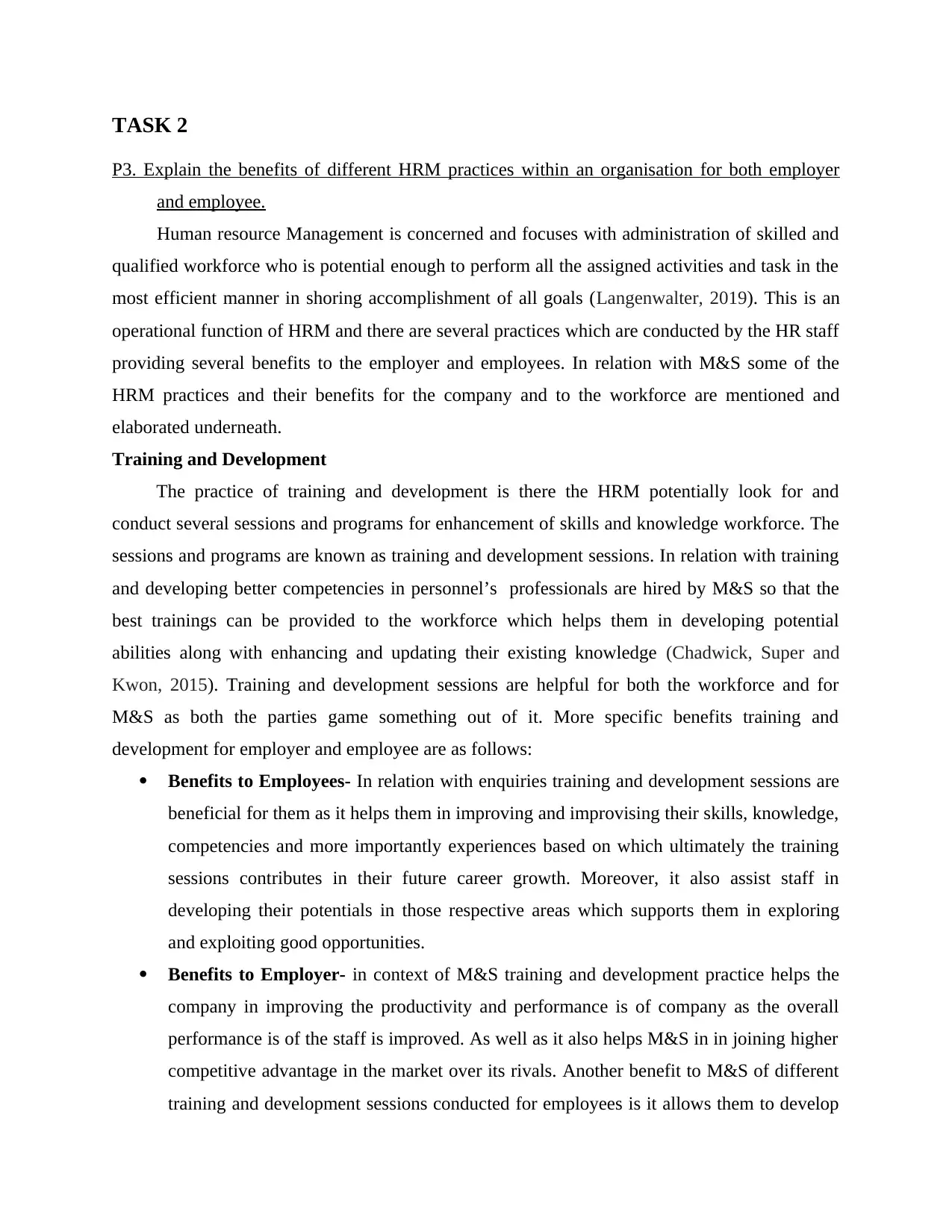
TASK 2
P3. Explain the benefits of different HRM practices within an organisation for both employer
and employee.
Human resource Management is concerned and focuses with administration of skilled and
qualified workforce who is potential enough to perform all the assigned activities and task in the
most efficient manner in shoring accomplishment of all goals (Langenwalter, 2019). This is an
operational function of HRM and there are several practices which are conducted by the HR staff
providing several benefits to the employer and employees. In relation with M&S some of the
HRM practices and their benefits for the company and to the workforce are mentioned and
elaborated underneath.
Training and Development
The practice of training and development is there the HRM potentially look for and
conduct several sessions and programs for enhancement of skills and knowledge workforce. The
sessions and programs are known as training and development sessions. In relation with training
and developing better competencies in personnel’s professionals are hired by M&S so that the
best trainings can be provided to the workforce which helps them in developing potential
abilities along with enhancing and updating their existing knowledge (Chadwick, Super and
Kwon, 2015). Training and development sessions are helpful for both the workforce and for
M&S as both the parties game something out of it. More specific benefits training and
development for employer and employee are as follows:
Benefits to Employees- In relation with enquiries training and development sessions are
beneficial for them as it helps them in improving and improvising their skills, knowledge,
competencies and more importantly experiences based on which ultimately the training
sessions contributes in their future career growth. Moreover, it also assist staff in
developing their potentials in those respective areas which supports them in exploring
and exploiting good opportunities.
Benefits to Employer- in context of M&S training and development practice helps the
company in improving the productivity and performance is of company as the overall
performance is of the staff is improved. As well as it also helps M&S in in joining higher
competitive advantage in the market over its rivals. Another benefit to M&S of different
training and development sessions conducted for employees is it allows them to develop
P3. Explain the benefits of different HRM practices within an organisation for both employer
and employee.
Human resource Management is concerned and focuses with administration of skilled and
qualified workforce who is potential enough to perform all the assigned activities and task in the
most efficient manner in shoring accomplishment of all goals (Langenwalter, 2019). This is an
operational function of HRM and there are several practices which are conducted by the HR staff
providing several benefits to the employer and employees. In relation with M&S some of the
HRM practices and their benefits for the company and to the workforce are mentioned and
elaborated underneath.
Training and Development
The practice of training and development is there the HRM potentially look for and
conduct several sessions and programs for enhancement of skills and knowledge workforce. The
sessions and programs are known as training and development sessions. In relation with training
and developing better competencies in personnel’s professionals are hired by M&S so that the
best trainings can be provided to the workforce which helps them in developing potential
abilities along with enhancing and updating their existing knowledge (Chadwick, Super and
Kwon, 2015). Training and development sessions are helpful for both the workforce and for
M&S as both the parties game something out of it. More specific benefits training and
development for employer and employee are as follows:
Benefits to Employees- In relation with enquiries training and development sessions are
beneficial for them as it helps them in improving and improvising their skills, knowledge,
competencies and more importantly experiences based on which ultimately the training
sessions contributes in their future career growth. Moreover, it also assist staff in
developing their potentials in those respective areas which supports them in exploring
and exploiting good opportunities.
Benefits to Employer- in context of M&S training and development practice helps the
company in improving the productivity and performance is of company as the overall
performance is of the staff is improved. As well as it also helps M&S in in joining higher
competitive advantage in the market over its rivals. Another benefit to M&S of different
training and development sessions conducted for employees is it allows them to develop
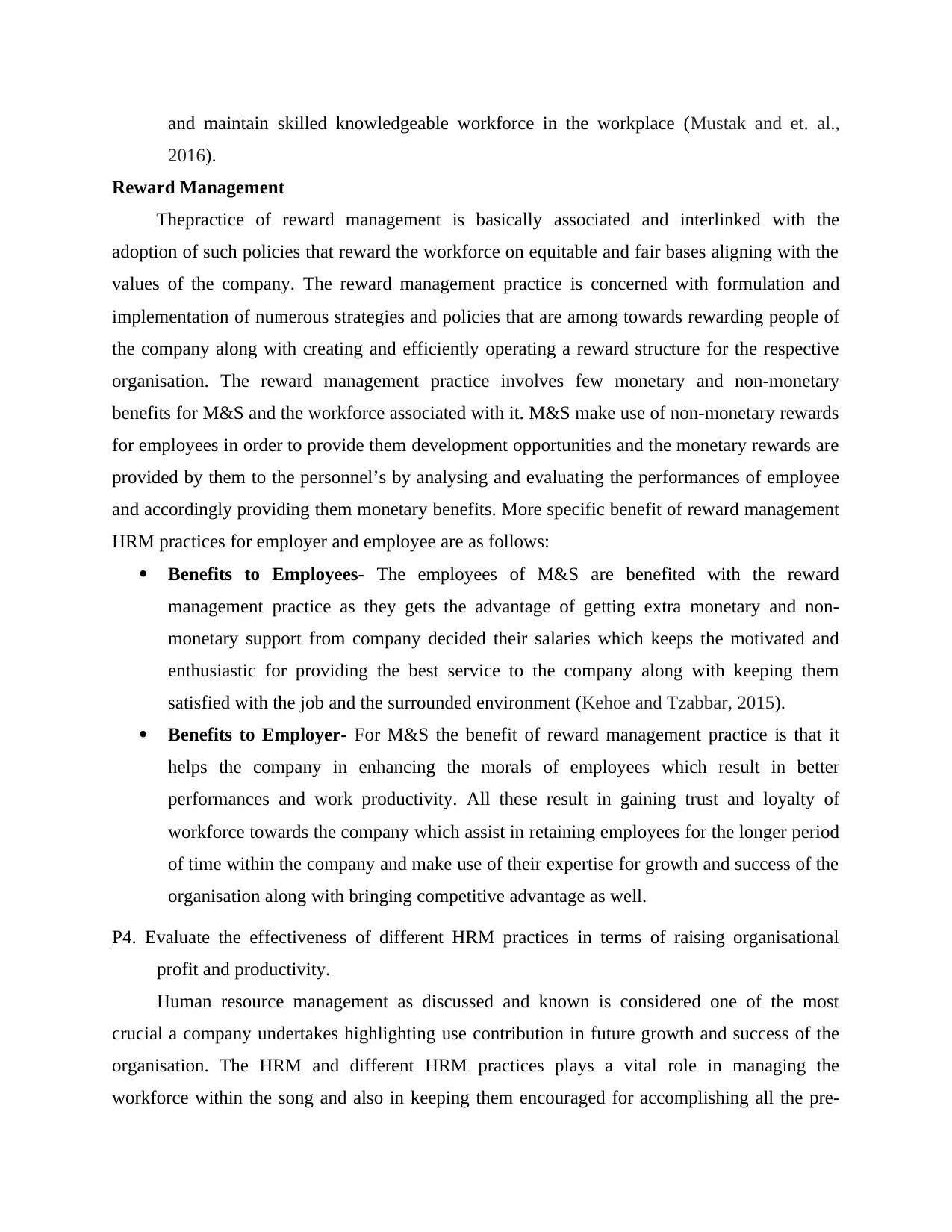
and maintain skilled knowledgeable workforce in the workplace (Mustak and et. al.,
2016).
Reward Management
Thepractice of reward management is basically associated and interlinked with the
adoption of such policies that reward the workforce on equitable and fair bases aligning with the
values of the company. The reward management practice is concerned with formulation and
implementation of numerous strategies and policies that are among towards rewarding people of
the company along with creating and efficiently operating a reward structure for the respective
organisation. The reward management practice involves few monetary and non-monetary
benefits for M&S and the workforce associated with it. M&S make use of non-monetary rewards
for employees in order to provide them development opportunities and the monetary rewards are
provided by them to the personnel’s by analysing and evaluating the performances of employee
and accordingly providing them monetary benefits. More specific benefit of reward management
HRM practices for employer and employee are as follows:
Benefits to Employees- The employees of M&S are benefited with the reward
management practice as they gets the advantage of getting extra monetary and non-
monetary support from company decided their salaries which keeps the motivated and
enthusiastic for providing the best service to the company along with keeping them
satisfied with the job and the surrounded environment (Kehoe and Tzabbar, 2015).
Benefits to Employer- For M&S the benefit of reward management practice is that it
helps the company in enhancing the morals of employees which result in better
performances and work productivity. All these result in gaining trust and loyalty of
workforce towards the company which assist in retaining employees for the longer period
of time within the company and make use of their expertise for growth and success of the
organisation along with bringing competitive advantage as well.
P4. Evaluate the effectiveness of different HRM practices in terms of raising organisational
profit and productivity.
Human resource management as discussed and known is considered one of the most
crucial a company undertakes highlighting use contribution in future growth and success of the
organisation. The HRM and different HRM practices plays a vital role in managing the
workforce within the song and also in keeping them encouraged for accomplishing all the pre-
2016).
Reward Management
Thepractice of reward management is basically associated and interlinked with the
adoption of such policies that reward the workforce on equitable and fair bases aligning with the
values of the company. The reward management practice is concerned with formulation and
implementation of numerous strategies and policies that are among towards rewarding people of
the company along with creating and efficiently operating a reward structure for the respective
organisation. The reward management practice involves few monetary and non-monetary
benefits for M&S and the workforce associated with it. M&S make use of non-monetary rewards
for employees in order to provide them development opportunities and the monetary rewards are
provided by them to the personnel’s by analysing and evaluating the performances of employee
and accordingly providing them monetary benefits. More specific benefit of reward management
HRM practices for employer and employee are as follows:
Benefits to Employees- The employees of M&S are benefited with the reward
management practice as they gets the advantage of getting extra monetary and non-
monetary support from company decided their salaries which keeps the motivated and
enthusiastic for providing the best service to the company along with keeping them
satisfied with the job and the surrounded environment (Kehoe and Tzabbar, 2015).
Benefits to Employer- For M&S the benefit of reward management practice is that it
helps the company in enhancing the morals of employees which result in better
performances and work productivity. All these result in gaining trust and loyalty of
workforce towards the company which assist in retaining employees for the longer period
of time within the company and make use of their expertise for growth and success of the
organisation along with bringing competitive advantage as well.
P4. Evaluate the effectiveness of different HRM practices in terms of raising organisational
profit and productivity.
Human resource management as discussed and known is considered one of the most
crucial a company undertakes highlighting use contribution in future growth and success of the
organisation. The HRM and different HRM practices plays a vital role in managing the
workforce within the song and also in keeping them encouraged for accomplishing all the pre-
⊘ This is a preview!⊘
Do you want full access?
Subscribe today to unlock all pages.

Trusted by 1+ million students worldwide
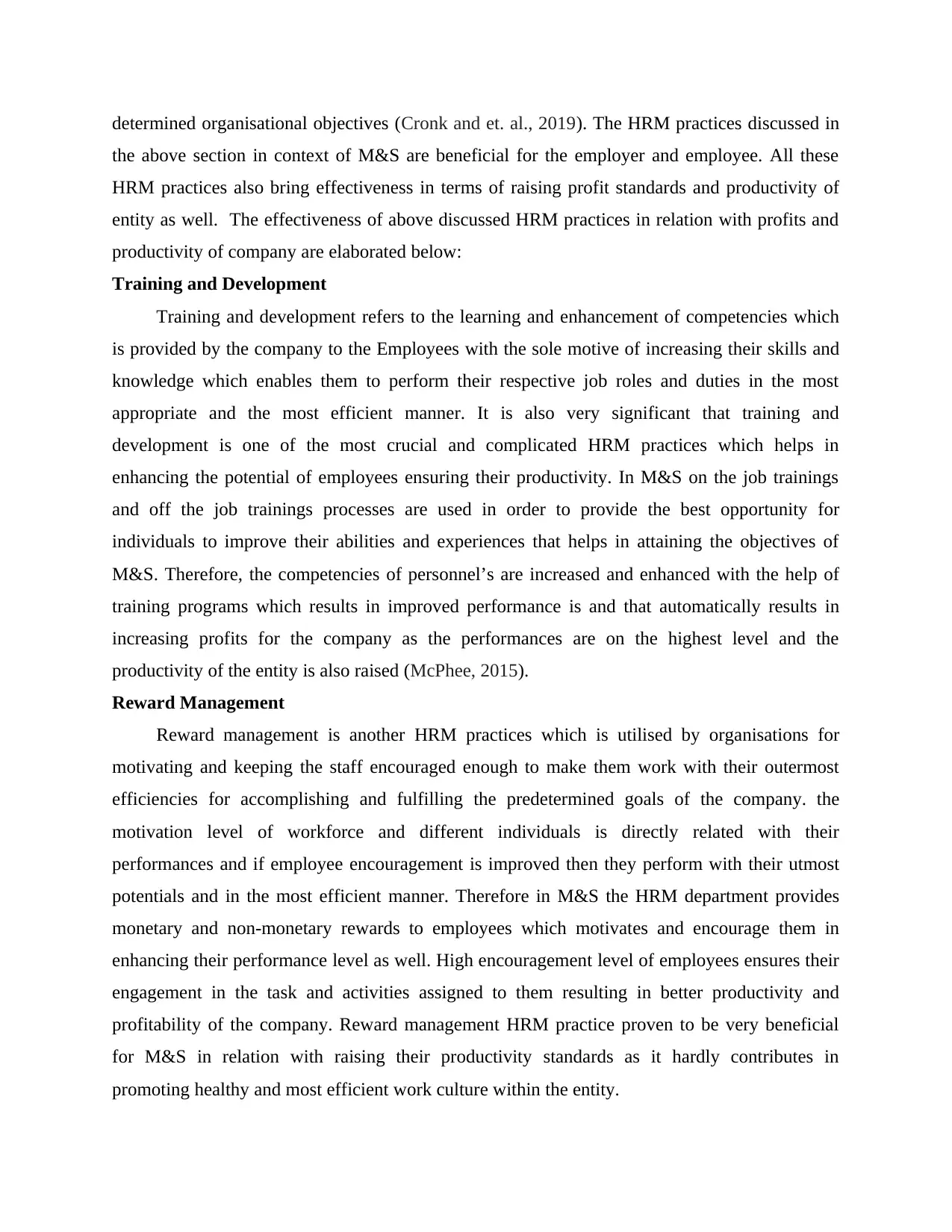
determined organisational objectives (Cronk and et. al., 2019). The HRM practices discussed in
the above section in context of M&S are beneficial for the employer and employee. All these
HRM practices also bring effectiveness in terms of raising profit standards and productivity of
entity as well. The effectiveness of above discussed HRM practices in relation with profits and
productivity of company are elaborated below:
Training and Development
Training and development refers to the learning and enhancement of competencies which
is provided by the company to the Employees with the sole motive of increasing their skills and
knowledge which enables them to perform their respective job roles and duties in the most
appropriate and the most efficient manner. It is also very significant that training and
development is one of the most crucial and complicated HRM practices which helps in
enhancing the potential of employees ensuring their productivity. In M&S on the job trainings
and off the job trainings processes are used in order to provide the best opportunity for
individuals to improve their abilities and experiences that helps in attaining the objectives of
M&S. Therefore, the competencies of personnel’s are increased and enhanced with the help of
training programs which results in improved performance is and that automatically results in
increasing profits for the company as the performances are on the highest level and the
productivity of the entity is also raised (McPhee, 2015).
Reward Management
Reward management is another HRM practices which is utilised by organisations for
motivating and keeping the staff encouraged enough to make them work with their outermost
efficiencies for accomplishing and fulfilling the predetermined goals of the company. the
motivation level of workforce and different individuals is directly related with their
performances and if employee encouragement is improved then they perform with their utmost
potentials and in the most efficient manner. Therefore in M&S the HRM department provides
monetary and non-monetary rewards to employees which motivates and encourage them in
enhancing their performance level as well. High encouragement level of employees ensures their
engagement in the task and activities assigned to them resulting in better productivity and
profitability of the company. Reward management HRM practice proven to be very beneficial
for M&S in relation with raising their productivity standards as it hardly contributes in
promoting healthy and most efficient work culture within the entity.
the above section in context of M&S are beneficial for the employer and employee. All these
HRM practices also bring effectiveness in terms of raising profit standards and productivity of
entity as well. The effectiveness of above discussed HRM practices in relation with profits and
productivity of company are elaborated below:
Training and Development
Training and development refers to the learning and enhancement of competencies which
is provided by the company to the Employees with the sole motive of increasing their skills and
knowledge which enables them to perform their respective job roles and duties in the most
appropriate and the most efficient manner. It is also very significant that training and
development is one of the most crucial and complicated HRM practices which helps in
enhancing the potential of employees ensuring their productivity. In M&S on the job trainings
and off the job trainings processes are used in order to provide the best opportunity for
individuals to improve their abilities and experiences that helps in attaining the objectives of
M&S. Therefore, the competencies of personnel’s are increased and enhanced with the help of
training programs which results in improved performance is and that automatically results in
increasing profits for the company as the performances are on the highest level and the
productivity of the entity is also raised (McPhee, 2015).
Reward Management
Reward management is another HRM practices which is utilised by organisations for
motivating and keeping the staff encouraged enough to make them work with their outermost
efficiencies for accomplishing and fulfilling the predetermined goals of the company. the
motivation level of workforce and different individuals is directly related with their
performances and if employee encouragement is improved then they perform with their utmost
potentials and in the most efficient manner. Therefore in M&S the HRM department provides
monetary and non-monetary rewards to employees which motivates and encourage them in
enhancing their performance level as well. High encouragement level of employees ensures their
engagement in the task and activities assigned to them resulting in better productivity and
profitability of the company. Reward management HRM practice proven to be very beneficial
for M&S in relation with raising their productivity standards as it hardly contributes in
promoting healthy and most efficient work culture within the entity.
Paraphrase This Document
Need a fresh take? Get an instant paraphrase of this document with our AI Paraphraser
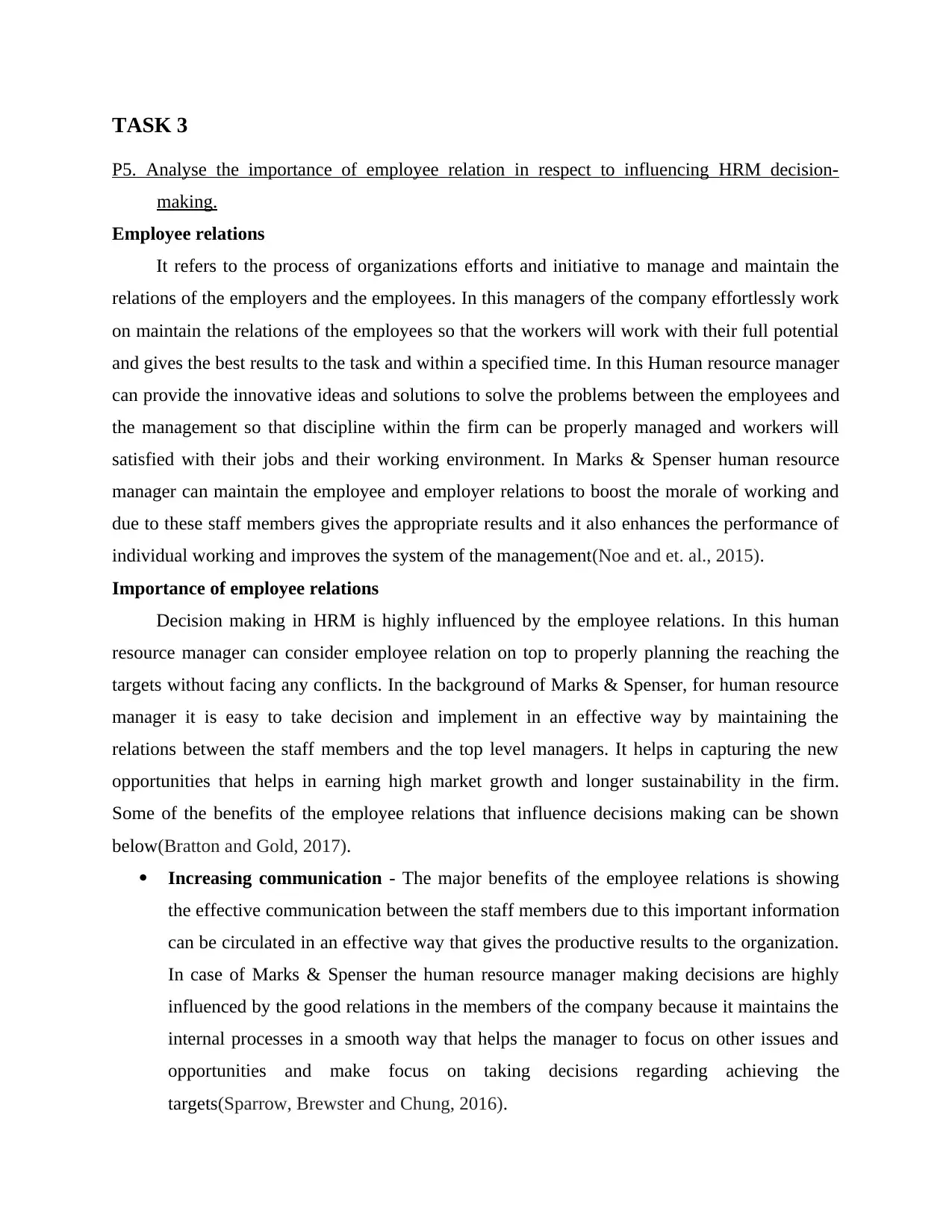
TASK 3
P5. Analyse the importance of employee relation in respect to influencing HRM decision-
making.
Employee relations
It refers to the process of organizations efforts and initiative to manage and maintain the
relations of the employers and the employees. In this managers of the company effortlessly work
on maintain the relations of the employees so that the workers will work with their full potential
and gives the best results to the task and within a specified time. In this Human resource manager
can provide the innovative ideas and solutions to solve the problems between the employees and
the management so that discipline within the firm can be properly managed and workers will
satisfied with their jobs and their working environment. In Marks & Spenser human resource
manager can maintain the employee and employer relations to boost the morale of working and
due to these staff members gives the appropriate results and it also enhances the performance of
individual working and improves the system of the management(Noe and et. al., 2015).
Importance of employee relations
Decision making in HRM is highly influenced by the employee relations. In this human
resource manager can consider employee relation on top to properly planning the reaching the
targets without facing any conflicts. In the background of Marks & Spenser, for human resource
manager it is easy to take decision and implement in an effective way by maintaining the
relations between the staff members and the top level managers. It helps in capturing the new
opportunities that helps in earning high market growth and longer sustainability in the firm.
Some of the benefits of the employee relations that influence decisions making can be shown
below(Bratton and Gold, 2017).
Increasing communication - The major benefits of the employee relations is showing
the effective communication between the staff members due to this important information
can be circulated in an effective way that gives the productive results to the organization.
In case of Marks & Spenser the human resource manager making decisions are highly
influenced by the good relations in the members of the company because it maintains the
internal processes in a smooth way that helps the manager to focus on other issues and
opportunities and make focus on taking decisions regarding achieving the
targets(Sparrow, Brewster and Chung, 2016).
P5. Analyse the importance of employee relation in respect to influencing HRM decision-
making.
Employee relations
It refers to the process of organizations efforts and initiative to manage and maintain the
relations of the employers and the employees. In this managers of the company effortlessly work
on maintain the relations of the employees so that the workers will work with their full potential
and gives the best results to the task and within a specified time. In this Human resource manager
can provide the innovative ideas and solutions to solve the problems between the employees and
the management so that discipline within the firm can be properly managed and workers will
satisfied with their jobs and their working environment. In Marks & Spenser human resource
manager can maintain the employee and employer relations to boost the morale of working and
due to these staff members gives the appropriate results and it also enhances the performance of
individual working and improves the system of the management(Noe and et. al., 2015).
Importance of employee relations
Decision making in HRM is highly influenced by the employee relations. In this human
resource manager can consider employee relation on top to properly planning the reaching the
targets without facing any conflicts. In the background of Marks & Spenser, for human resource
manager it is easy to take decision and implement in an effective way by maintaining the
relations between the staff members and the top level managers. It helps in capturing the new
opportunities that helps in earning high market growth and longer sustainability in the firm.
Some of the benefits of the employee relations that influence decisions making can be shown
below(Bratton and Gold, 2017).
Increasing communication - The major benefits of the employee relations is showing
the effective communication between the staff members due to this important information
can be circulated in an effective way that gives the productive results to the organization.
In case of Marks & Spenser the human resource manager making decisions are highly
influenced by the good relations in the members of the company because it maintains the
internal processes in a smooth way that helps the manager to focus on other issues and
opportunities and make focus on taking decisions regarding achieving the
targets(Sparrow, Brewster and Chung, 2016).
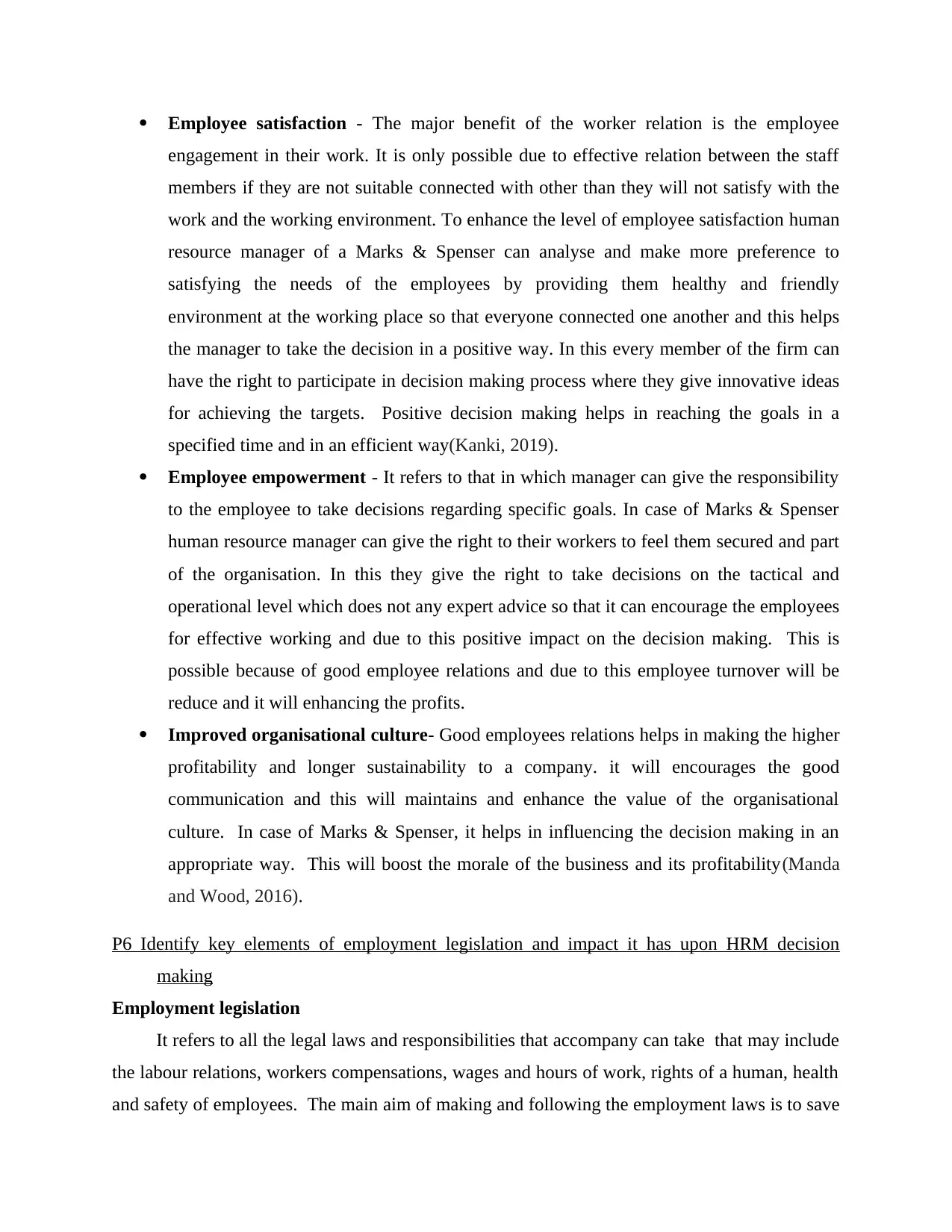
Employee satisfaction - The major benefit of the worker relation is the employee
engagement in their work. It is only possible due to effective relation between the staff
members if they are not suitable connected with other than they will not satisfy with the
work and the working environment. To enhance the level of employee satisfaction human
resource manager of a Marks & Spenser can analyse and make more preference to
satisfying the needs of the employees by providing them healthy and friendly
environment at the working place so that everyone connected one another and this helps
the manager to take the decision in a positive way. In this every member of the firm can
have the right to participate in decision making process where they give innovative ideas
for achieving the targets. Positive decision making helps in reaching the goals in a
specified time and in an efficient way(Kanki, 2019).
Employee empowerment - It refers to that in which manager can give the responsibility
to the employee to take decisions regarding specific goals. In case of Marks & Spenser
human resource manager can give the right to their workers to feel them secured and part
of the organisation. In this they give the right to take decisions on the tactical and
operational level which does not any expert advice so that it can encourage the employees
for effective working and due to this positive impact on the decision making. This is
possible because of good employee relations and due to this employee turnover will be
reduce and it will enhancing the profits.
Improved organisational culture- Good employees relations helps in making the higher
profitability and longer sustainability to a company. it will encourages the good
communication and this will maintains and enhance the value of the organisational
culture. In case of Marks & Spenser, it helps in influencing the decision making in an
appropriate way. This will boost the morale of the business and its profitability(Manda
and Wood, 2016).
P6 Identify key elements of employment legislation and impact it has upon HRM decision
making
Employment legislation
It refers to all the legal laws and responsibilities that accompany can take that may include
the labour relations, workers compensations, wages and hours of work, rights of a human, health
and safety of employees. The main aim of making and following the employment laws is to save
engagement in their work. It is only possible due to effective relation between the staff
members if they are not suitable connected with other than they will not satisfy with the
work and the working environment. To enhance the level of employee satisfaction human
resource manager of a Marks & Spenser can analyse and make more preference to
satisfying the needs of the employees by providing them healthy and friendly
environment at the working place so that everyone connected one another and this helps
the manager to take the decision in a positive way. In this every member of the firm can
have the right to participate in decision making process where they give innovative ideas
for achieving the targets. Positive decision making helps in reaching the goals in a
specified time and in an efficient way(Kanki, 2019).
Employee empowerment - It refers to that in which manager can give the responsibility
to the employee to take decisions regarding specific goals. In case of Marks & Spenser
human resource manager can give the right to their workers to feel them secured and part
of the organisation. In this they give the right to take decisions on the tactical and
operational level which does not any expert advice so that it can encourage the employees
for effective working and due to this positive impact on the decision making. This is
possible because of good employee relations and due to this employee turnover will be
reduce and it will enhancing the profits.
Improved organisational culture- Good employees relations helps in making the higher
profitability and longer sustainability to a company. it will encourages the good
communication and this will maintains and enhance the value of the organisational
culture. In case of Marks & Spenser, it helps in influencing the decision making in an
appropriate way. This will boost the morale of the business and its profitability(Manda
and Wood, 2016).
P6 Identify key elements of employment legislation and impact it has upon HRM decision
making
Employment legislation
It refers to all the legal laws and responsibilities that accompany can take that may include
the labour relations, workers compensations, wages and hours of work, rights of a human, health
and safety of employees. The main aim of making and following the employment laws is to save
⊘ This is a preview!⊘
Do you want full access?
Subscribe today to unlock all pages.

Trusted by 1+ million students worldwide
1 out of 20
Related Documents
Your All-in-One AI-Powered Toolkit for Academic Success.
+13062052269
info@desklib.com
Available 24*7 on WhatsApp / Email
![[object Object]](/_next/static/media/star-bottom.7253800d.svg)
Unlock your academic potential
Copyright © 2020–2025 A2Z Services. All Rights Reserved. Developed and managed by ZUCOL.





